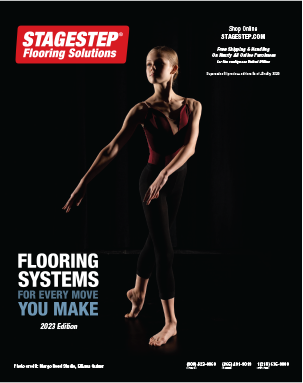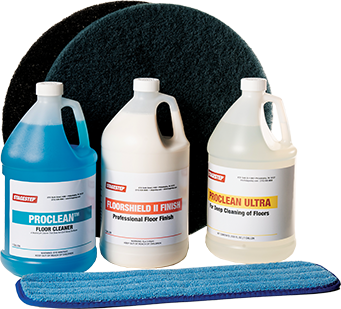What Is Percussive Dance?
Percussive dance is any form of dance that requires the dancer to strike the floor with force to create and generate sound. Percussive dance and its many variations include: tap, clogging, Irish dance, some forms of Indian Dance, character/folkloric, South African Boot, flamenco, African and some Native American Dance. Percussive sound is also used in cheer, spirit, and social dance.
What are the important elements of an excellent percussive dance floor?
- Sound
- Lateral foot support
- Structural integrity
- Shock absorbency
- Coefficient of friction
- Care/Maintenance
Sound
Since the primary purpose of a percussive floor is to generate sound, or through impact cause an “instrument” to generate sound, such as with taps or kathak bells, sound generation is a critical consideration in determining your flooring system choice. In a studio or on stage, generating sound also may involve amplifying it.
Hardwood or a heavy-duty marley are the best choices for your wear layer. Stay away from pine and bamboo. They are too soft. Instead, consider oak, maple, or ash.
Marley floors that are soft, reversible, or have foam backing are not going to help create sound or stand up to the abuse that percussive dance inflicts. Select a hard, dense marley designed for tap and percussive dance.
The selection of the top surface is only part of the story. Your subfloor is in fact, the most important element in creating sound.
Install wood or marley over carpet or rubber and the sound is degraded to the point of an unacceptable dull thud. Install over a floating wood subfloor with a dead air space between the slab and the wood and the sound is amplified. On stage in a theatre, most floors need to be miked. Stagestep’s Encore portable hardwood flooring system, in many cases, does not require artificial sound amplification. Besides the volume of sound, another consideration is the quality of the sound. Equalizers can help for amplified floors along with proper placement of the mikes.
In a studio, wood floors tend to sound better. However, a heavy-duty marley over a floating wood subfloor is a close second. Acoustics in the room can add or subtract amplitude and sound quality. Room acoustics can be adjusted by the placement of absorptive or reflective sound elements on the walls.
Lateral Foot Support
Whether you dance in shoes, boots, socks, or bare feet, balance is a critical element. It is especially important with percussive dance because it is usually one foot that is striking the floor while the other is used for balance even if it is for a microsecond.
Lateral foot support is the ability of the floor to provide a level and stable surface for the balancing foot. The surface itself must remain supportive of the balancing foot. A trampoline is an example of a surface that provides virtually no critical support laterally. Surfaces relying on direct contact with compression materials such as foam, rubber, or any spongy substance is virtually impossible to work on because it does not provide consistent stability. A suspended (floating) wood subfloor is ideal.
Structural Integrity
Every time a dancer jumps, three times their body weight impacts the floor. Multiply by twenty to forty dancers per class, and the structural integrity of your flooring system becomes a concern.
If you are building your own subfloor, use two layers of ½” plywood. Using the correct amount of foam blocks, cubes, or forms is very important; too many and you lose safe return of reliant energy; not enough foam can cause it to compress resulting in subfloor failure. If you are using alternative materials test the tenacity of the subfloor before building out. Stagestep has an installation guide online that details materials to use in building your own floating subfloor.
Shock The Floor, Not You
All that percussive banging into the floor can negatively impact your body. Stress fracture, fatigue, and knee, foot, and back injuries can quickly follow. The transfer of energy into the floor needs to be wicked away, or safely returned via resilient energy (spring). It is critically important to the health and well-being of the dancers and their teacher. Suspended floating wood floors flex and return safe energy (with less impact) to the dancer. Foam systems below the subfloor wood compress, absorbing energy, so the overall result is reduced impact to the body by 35-60%, depending on the materials and configuration of the floating wood subfloor. A flooring system that reduces shock is a safer floor.
Surface friction can rub you the wrong way.
Percussive dance varies in technique and footwear (or bare feet). How that floor feels can impact comfort and performance. It is important to match your dance style to the floor that works for you. Test or have a history of the floor surface before you buy. Check with the sales team. Wood can be rough or smooth. It can be very non-slip or as fast as ice. Marley floors usually operate in a narrower range; however, they can be textured or smooth and the difference can make a difference.
Care and Maintenance of Percussive Flooring
Percussive dance can be particularly hard on floors. Irish, tap, and flamenco can wear and tear a floor surface plus leave behind residue, scuff, and dye marks.
Wood and vinyl can get dented or scuffed especially if shoes are in disrepair. So, the first thing to do is maintain, clean and inspect your shoes. A loose screw, nail or worn tap can cause immediate and permanent damage.
Clean the floor regularly with a detergent/degreaser (Proclean). This will pick up dirt, grime, and perspiration. It will not eliminate scuff or dye marks. You will need Wipeout Plus to be used as a spot remover. You may need a stiff brush to assist in removing scuff and dye marks before cleaning with ProClean detergent/degreaser.
Do not let the dye or scuff marks remain on your floor for any length of time. Left to their devices they will transmute into your floor making it almost impossible to remove.
Aluminum compound residue requires completely different techniques to remove. Detergent and water will not help. Check out Stagestep’s Maintenance Guide at stagestep.com for all the answers. Twice a year, or perhaps more often, deep clean your floor with ProClean Ultra and a floor machine, and a green pad. Wood floors will need to be screened and/or sanded periodically depending on use. Floorshield II is a protective floor finish made especially for dance and is available for both wood and marley floors. It will protect the surface, reduce maintenance and maintain a safe non-slip consistency.
Conclusion: Percussive floors that do the job for the way you move require several considerations; sound volume and quality, structural integrity, shock absorption, proper floor, and shoe maintenance, and appropriate surface friction. If you have any questions our Stagestep associates would be happy to help. Online you can request samples and/or a quote. For a more personal touch call 800-523-0960.



